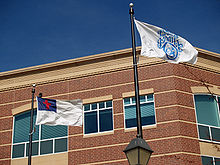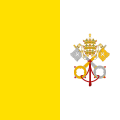- Christian Flag
-
The Christian Flag is a flag designed in the early 20th century to represent all of Christianity and Christendom, and has been most popular among Christian churches in North America, Africa and Latin America. The flag has a white field, with a red Latin cross inside a blue canton. The shade of red on the cross symbolizes the blood Jesus shed on Calvary.[1] The blue represents the waters of baptism as well as the faithfulness of Jesus, who was obedient unto death.[2] The white represents Jesus' purity.[2] In conventional vexillology, a white flag is linked to surrender, a reference to the Biblical description Jesus' non-violence and surrender to God's will.[2] The dimensions of the flag and canton have no official specifications.
Contents
Origins
The Christian Flag was first conceived on September 26, 1897, at Brighton Chapel on Coney Island in Brooklyn, New York in the United States. The superintendent of a Sunday school, Charles C. Overton, was forced to give an impromptu lecture to the gathered students, because the scheduled speaker had failed to arrive for the event. Overton saw a flag of the United States in the front of the chapel (a common custom in many American churches). Drawing on the flag for inspiration, he gave a speech asking the students what a flag representing Christianity would look like.
Overton thought about his improvised speech for many years afterward. In 1907, he and Ralph Diffendorfer, secretary of the Methodist Young People's Missionary Movement, designed and began promoting the flag.
Symbolism
Since the Christian Flag was inspired by the flag of the United States, it takes its colors and overall design from the American flag.
The flag's most conspicuous symbol is the Christian cross, the most universal symbol for Christianity. The red color is intended to represent the blood of Jesus as described in the story of his crucifixion. Christians believe that Jesus' death and resurrection is the means God uses to save believers from their sins. The cross and blood have been used since earliest Christianity to symbolize salvation through Jesus; in the words of the Apostle Paul, "Through [Jesus] God reconciles himself to all things... making peace by the blood of the cross" (Colossians 1:20).
The white field draws on symbolism throughout the Bible equating white clothes with purity and forgiveness. People who have been "washed white as snow" in the Bible have been cleansed from their sins (Isaiah 1:18). In conventional vexillology, a white flag is linked to surrender, a reference to the Biblical description Jesus' non-violence and surrender to God's will. In terms of its relations to other flag uses, the white field would be advised against in conventional flag design, as it is easily mistaken for the white flag of surrender.
The blue square represents faithfulness, truth, and sincerity.[3]
Since the flag is not tied to any specific religious denomination or church institution, it signifies the unity of all followers of Jesus Christ within the Christian Kingdom of God despite historical, cultural, and dogmatic differences. Its simplicity makes it easily reproduced, and there is no copyright associated with it.
Usage
 The Christian Flag displayed alongside the flag of the United States next to the pulpit in a church in California. Note the eagle and cross finials on the flag poles.
The Christian Flag displayed alongside the flag of the United States next to the pulpit in a church in California. Note the eagle and cross finials on the flag poles.
The flag was first accepted by the Mainline Protestant denominations in the United States, and by the 1980s many institutions had described policies for displaying it inside churches. During World War II the flag was flown along with the U.S. flag in a number of Lutheran churches, many of them with German backgrounds, who wanted to show their solidarity with the United States during the war with Germany.[citation needed]
The Christian Flag spread outside North America with Protestant missionaries. It can be seen today in or outside many Protestant churches throughout the world, particularly in Latin America and Africa. It has so far been adopted by very few churches in Europe. Roman Catholic, Eastern Orthodox, and other non-Protestant branches of Christianity have only recently started to use the flag.[citation needed]
Pledge
Some American churches practice a "pledge of allegiance" or "affirmation of loyalty" to the Christian Flag, based on the Pledge of Allegiance to the American flag. There are various versions of the pledge, including the following:
I pledge allegiance to the Christian Flag, and to the Savior, for whose kingdom it stands. One Savior, crucified, risen and coming again, with life and liberty for all who believe.
I pledge allegiance to the Christian Flag and to the Savior for whose kingdom it stands; One Savior, crucified, risen, and coming again with life and Liberty to all who repent and believe The Gospel
I pledge allegiance to the Christian flag and to the Savior for whose kingdom it stands; One brotherhood, uniting all true Christians in service and in love.
I pledge allegiance to the Christian flag and to the gospel for which it stands; One Savior, crucified, risen and coming again, with life eternal for all who believe.
Other Christian flags
In the United States, Catholic Churches in communion with the Holy See often display the Vatican flag along with the American flag, typically opposite sides of the sanctuary, near the front door, or outside.
Eastern Orthodox Churches, particularly jurisdictions of the Greek Orthodox Church under the direct authority of the Ecumenical Patriarch, often display his flag, which is a Byzantine double-headed eagle on a yellow (Or) field.
Additionally, both Catholic and Orthodox Churches maintain the use of the Labarum, a historical symbol of Christianity, which is rarely used as a flag at present.
Parishes in the Episcopal Church frequently fly the Episcopal flag, a Cross of St. George with the upper-left canton containing a Cross of St. Andrew formed by nine cross-crosslets (representing the nine original dioceses) on a blue background.
The Salvation Army has a flag with a blue border (symbolizing the purity of God the Father), a red field (symbolizing the blood of Jesus Christ), and a gold eight-pointed star (symbolizing the fire of the Holy Spirit). The star bears the Salvation army's motto, "Blood and Fire".
The Anglican Communion have a blue flag with a Cross of St George in the centre surrounded with a gold band with the wording, "The Truth shall make you free." in New Testament Greek on it. From the band sprout the points of a compass (symbolising the spread worldwide of Anglicanism). On the "North" of the compass is a mitre (a symbol of apostolic order essential to all Churches and Provinces constituting the Anglican Communion).
The Church of Scotland use a Flag of Scotland defaced with a Burning Bush.
The Church in Wales use a blue Cross of St George defaced with a gold Celtic Cross.
The Church of Ireland use the St Patrick's Saltire but also use the Compass-rose Flag of the Anglican Communion equally.
-
Flag of the Greek Orthodox Church
-
Flag of the Episcopal Church
-
Flag of the Copts - the Christians of Egypt
-
Standard of The Salvation Army
-
Flag of the Church of Scotland
-
Flag of the Church in Wales
-
Flag of the Church of Ireland
See also
References
- ^ "The Christian Flag". Bob Jones University. http://www.bju.edu/library/collections/fund_file/chriflg1.html. Retrieved 2007–10–18. "The white on the flag represents purity and peace. The blue stands for faithfulness, truth, and sincerity. Red, of course, is the color of sacrifice, in this case calling to mind the blood shed by Christ on Calvary, represented by the cross."
- ^ a b c "The Christian Flag". Prayer Foundation. http://www.prayerfoundation.org/christian_flag.htm. Retrieved 2007–10–18. "The flag's most conspicuous symbol is the Christian cross, the most universal symbol for Christianity. The red color represents the blood of Christ and brings to mind his crucifixion. Christians believe that Jesus Christ's death and resurrection is the means God uses to save believers from their sins. The cross and blood have been used since earliest Christianity to symbolize salvation through Jesus; in the words of the Apostle Paul, "And having made peace through the blood of his cross, by him to reconcile all things unto himself;" -Colossians 1:20. The white field draws on symbolism throughout the Bible equating white clothes with purity and forgiveness. People who have been "washed white as snow" in the Bible have been cleansed from their sins (Isaiah 1:18; Psalm 51:2). In conventional vexillology (the study of flags, their history and sybolism), a white flag is linked to surrender, a reference to the Biblical description Jesus' non-violence and surrender to God's will. The symbolism behind the blue canton has been interpreted to represent Heaven, truth, or the Christian ritual of Baptism in water."
- ^ http://www.bju.edu/library/collections/fund_file/chriflg1.html
- Coffman, Elesha. "Ask the Editors." Christian History & Biography. 13 July 2001. [1].
- Sidwell, Mark. "The Christian Flag", Fundamentalism File Research Report, 18 December 1998 [2]
- "Blood sacrifice and the nation: Revisiting civil religion", C. Marvin - Journal of the American Academy of Religion, 1996
- The Divided States of America?: What Liberals and Conservatives Get Wrong about Faith and Politics, Richard Land. Thomas Nelson, 2011 (revised ed.) (p. 41)
- Encyclopedia of Evangelicalism, Randall Herbert Balmer. Baylor University Press, 2002, p. 134
External links
Categories:- Christian symbols
- Christian ecumenism
- Religious flags
Wikimedia Foundation. 2010.












